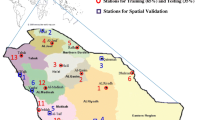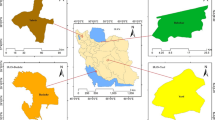Abstract
An accurate and simple Reference Evapotranspiration (ETo) numerical model eases to use for supporting irrigation planning and its effective management is highly desired in Sahelian regions. This paper investigates the performance ability of the Gene-expression Programming (GEP) for modeling ETo using decadal climatic data from a Sahelian country; Burkina Faso. For the study; important data are collected from six synoptic meteorological stations located in different regions; Gaoua, Pô, Boromo, Ouahigouya, Bogandé and Dori. The climatic data combinations are used as inputs to develop the GEP models at regional-specific data basis for estimating ETo. GEP performances are evaluated with the root mean square error (RMSE), and coefficient of correlation (R) between estimated and targeted Penman-Monteith FAO56 set as the true reference values. Obviously; from the statistical viewpoint; GEP computing technique has showed a good ability for providing numerical models on a regional data basis. The performances of GEP based on temperatures data are quite good able to substitute empirical equations at regional level to some extent. It is found that the models with wind velocity yield high accuracies by causing radical improve of the performances with R2 (0.925-0.961) and RMSE (0.131-0.272 mm day-1); while relative humidity may cause only (R2 = 0.801-0.933 and RMSE = 0.370-0.578 mm day-1). Statistically; GEP is an effectual modeling tool for computing successfully evapotranspiration in Sahel.





Similar content being viewed by others
References
Allen RG, Pereira LS, Raes D, Smith M (1998) Crop evapotranspiration, guideline for computing water requirements. FAO Irrigation drainage paper no 56, Rome, Italy
Aytek A, Kişi Ö (2008) Genetic programming approach to suspended sediment modelling. J Hydrol 351(3–4):288–298
Azamathulla HM, Ghani AA, Leow CS, Chang CK, Zakaria NA (2011) Gene-expression programming for the development of a stage-discharge curve of the Pahang River. Water Resour Manag 25(11):2901–2916
Cob AM, Juste MT (2004) A wind-based qualitative calibration of the Hargreaves ETo estimation equation in semiarid regions. Agr Water Manag 64:251–264
Dorado J, Rabunal JR, Pazos A, Rivero D, Santos A, Puertas J (2003) Prediction and modeling of the rainfall-runoff transformation of a typical urban basin using ANN and GP. Appl Artif Intell 17:329–343
Guven A (2009) Linear genetic programming for time-series modelling of daily flow rate. Hydrol Earth Syst Sci 118(2):137–146
Guven A, Aytek A (2009) New approach for stage–discharge relationship: gene-expression programming. J Hydrolog Eng 14(8):812–820
Guven A, Kisi Ö (2010) Daily pan evaporation modeling using linear genetic programming technique. Irrigat Sci 29(2):135–145
Guven A, Kisi Ö (2011) Estimation of suspended sediment yield in natural rivers using machine-coded linear genetic programming. Water Resour Manag 25:691–704
Guven A, Aytek A, Yuce MI, Aksoy H (2008) Genetic programming based empirical model for daily reference evapotranspiration estimation. Clean-Soil Air Water 36(10–11):905–912
Isidoro D, Quılez D, Aragüés R (2004) Water balance and irrigation performance analysis: La Violada irrigation district (Spain) as a case study. Agr Water Manag 64:123–142
Khoob AR (2008) Comparative study of Hargreaves’s and artificial neural network’s methodologies in estimating reference evapotranspiration in a semiarid environment. Irrigat Sci 26:253–259
Kisi O (2006) Generalized regression neural networks for evapotranspiration modelling. Hydrolog Sci J 51(6):1092–1104
Kisi O, Shiri J (2011) Precipitation forecasting using wavelet-genetic programming and wavelet-neuro-fuzzy conjunction models. Water Resour Manag 25(13):3135–3152
Lopez-Urrea R, Olalla FMS, Fabeiro C, Moratalla A (2006) An evaluation of two hourly reference evapotranspiration equations for semiarid conditions. Agr Water Manag J 86:277–282
Popova Z, Kercheva M, Pereira LS (2006) Validation of the FAO methodology for computing ETo with limited data: Application to south Bulgaria. Irrigat Drain 55:201–215
Temesgen B, Allen RG, Jensen DT (1999) Adjusting temperature parameters to reflect well-water conditions. J Irrigat Drain Eng 125:26–33
Trajkovic S (2005) Temperature-based approaches for estimating reference evapotranspiration. J Irrigat Drain Eng 131(4):316–323
Traore S, Guven A (2011) New algebraic formulations of evapotranspiration extracted from gene-expression programming in the tropical seasonally dry regions of West Africa. Irrigat Sci. doi:10.1007/s00271-011-0288-y
Traore S, Wang YM, Kerh T (2008) Modeling reference evapotranspiration by generalized regression neural network in semiarid zone of Africa. WSEAS Trans Inf Sci & Appl 6(5):991–1000
Traore S, Wang YM, Kan CE, Kerh T (2010a) A mixture neural methodology for computing rice consumptive water requirements in Fada N’Gourma Region, Eastern Burkina Faso. J Paddy & Wat Env 8(2):165–173
Traore S, Wang YM, Kan CE, Kerh T (2010b) Artificial neural network for modeling reference evapotranspiration complex process in Sudano-Sahelian zone. Agr Water Manag J 97:707–714
Wang YM, Traore S, Kerh T (2009) Computational performance of reference evapotranspiration in semiarid zone of Africa. Sci Res Essays 6(4):577–583
Wang YM, Traore S, Kerh T, Leu JM (2011) Modeling reference evapotranspiration using feed forward backpropagation algorithm in arid regions of Africa. Irrigat Drain 60(3):404–417
Author information
Authors and Affiliations
Corresponding author
Rights and permissions
About this article
Cite this article
Traore, S., Guven, A. Regional-Specific Numerical Models of Evapotranspiration Using Gene-Expression Programming Interface in Sahel. Water Resour Manage 26, 4367–4380 (2012). https://doi.org/10.1007/s11269-012-0149-3
Received:
Accepted:
Published:
Issue Date:
DOI: https://doi.org/10.1007/s11269-012-0149-3




